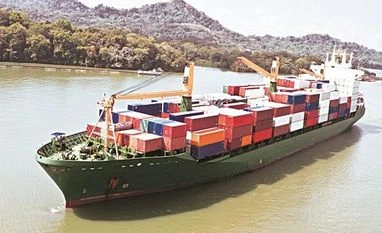When Prime Minister Narendra Modi received the food and beverage giant Pepsico’s container cargo at Varanasi on November 12, the event marked the beginning of a new chapter in the area of logistics.
Pepsico moved 16 containers -– equivalent to 16 truckloads -- filled with food and snacks in the vessel MV RN Tagore that sailed from Kolkata to Varanasi on National Waterway 1.
On its return journey, MV RN Tagore ferried fertilisers procured from Iffco's Phulpur plant near Prayagraj (erstwhile Allahabad).
When Union shipping minister Nitin Gadkari took charge of his office on May 29, 2014, development of inland waterways was listed a priority area.
Gadkari, who had also served as the PWD minister in the Maharashtra government from 1995-99, passionately flagged the need for an environment-friendly and cost-effective mode of transportation.
He had said his government would promote water transportation in order to ease traffic burden on roads. He claimed that the cost of water transportation at barely 50 paise per kilometre, is much lower than Re 1 by railways and Rs 1.5 a kilometre by road.
“The success of waterways as a cost effective mode of transportation will be determined by three main factors -- access to market for the company utilising the service, availability of infrastructure around the waterway and predictability of service,” says Jagannarayan Padmanabhan, director and practice lead, transport and logistics, Crisil.
Former shipping secretary Vishwapati Trivedi is of the view that cost-effectiveness can be ascertained on a case-by-case basis.
A RITES Report of 2014, titled 'Integrated National Waterways Transportation Grid', compared the cost of moving cargo by Inland Water Transport (IWT), with that of transporting it by road and rail.
The report estimated the cost of freight transportation by rail at Rs 1.36 per tonne-kilometre (TKM), highways at Rs 2.50 per TKM and inland waterways at Rs 1.06 per TKM.
TKM is a measure of freight carried by modes of transport, such as roads, railways, airways or waterways. It is calculated by multiplying the total load carried (measured in tonnes) and total distance covered (in kilometres).
Trivedi, however, said, "All this is contextual as it may not be true that waterways are better than railways. In the case of a waterway, last-mile connectivity may be provided by road, whereas in railways last-mile may not be an issue for a bulk commodity like coal, as steel or power units have rail termination points within their plants."
An industry expert said any company using inland waterways for freight transportation also pays the handling charges at the terminals and therefore that cost should also be factored in at the time of calculation of the total logistics cost.
These factors included make the movement of cargo via waterways relatively less efficient in terms of time and cost, he said.
In December 2015, the Union Cabinet approved central legislation to declare 111 inland waterways as national waterways, which includes five existing waterways.
The declaration of these National Waterways would enable the Inland Waterways Authority of India (IWAI) to develop the feasible stretches for shipping and navigation purposes.
The right over the use of water, river bed and the annexed land will remain with the state government.
The budgetary allocation for the Ministry of Shipping for the current financial year (2018-19) is Rs 18.81 billion, of which nearly one-fourth, or Rs 5.08 billion, is earmarked for implementation of inland waterway transportation projects.
In 2017-18, the budget allocation for the shipping ministry was Rs 15.68 billion and that of waterways was Rs 4.77 billion.
Unlock 30+ premium stories daily hand-picked by our editors, across devices on browser and app.
Pick your 5 favourite companies, get a daily email with all news updates on them.
Full access to our intuitive epaper - clip, save, share articles from any device; newspaper archives from 2006.
Preferential invites to Business Standard events.
Curated newsletters on markets, personal finance, policy & politics, start-ups, technology, and more.
)